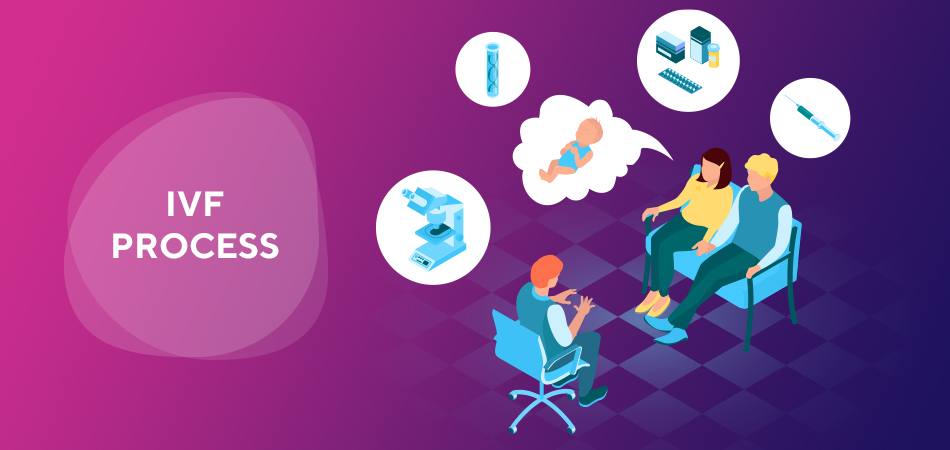
IVF Process
Posted Mar 02, 2020
In Vitro Fertilization – Embryo transfer in non-medical terms is referred to as “test-tube baby”. It involves picking up eggs from a woman, fertilizing them outside the body with the husband’s sperm, and replacing the resultant embryos into the patient’s uterus.
IVF is the treatment of choice for a couple with the following:
- Blocked fallopian tubes
- Severe abnormalities in the semen parameters.
- Unexplained infertility, with previous failed IUIs.
- Genetic diseases in either parent resulting in miscarriages/stillbirths.
- Women whose ovaries are failing due to age or other causes. Such women can undergo IVF with donated oocytes.
STAGES OF TREATMENT IN IVF
1. Downregulation
- Downregulation is accomplished by administering a drug called gonadotrophin-releasing hormone agonist (GnRHa). The response is monitored by blood tests and ultrasound scans. The treatment duration may vary between 8-21 days depending on the individual’s response.
2. Ovarian Stimulation
- Injections called gonadotrophins are the most commonly used injections to develop a good number of follicles in the ovary. They are given daily till the follicles reach a diameter of 18-22mm. This takes on an average of 10-12 days of treatment. Ovarian stimulation may also be achieved by tablets such as clomiphene citrate in combination with onadotrophins. Hormonal assays in the blood and ultrasound scans are carried out at regular intervals to assess the response to these drugs. At the same time, the endometrial lining is also assessed.
3. Ovulation Trigger
- This is accomplished by the administration of another drug called Human Chorionic Gonadotropin or HCG, which is necessary for the final maturation of the egg prior to ovulation.
- The next step i.e. oocyte retrieval is then scheduled at 34-36 hours after administration of HCG.
4. Oocyte retrieval or Ovum Pick up
- This is a short, safe, outpatient procedure performed vaginally under ultrasonographic guidance. It is usually done under sedation but general anesthesia can also be used.
- The patient should be fasting for at least 5 hours prior to the procedure.
- The procedure is carried out in sterile surroundings under aseptic conditions.
- The aspirated fluid is examined under the microscope to identify the eggs. The eggs are removed and washed and placed in small dishes containing culture medium. The dishes are kept in a special incubator.
After - Care
- There may be mild cramp-like pain or slight bleeding from the vagina which will subside in a few hours.
- Oral antibiotics are given to the woman as prophylaxis against infection.
- The patient should not drive for 24 hours after the procedure.
5. Sperm preparation
- On the day of egg pick-up, the husband is required to produce a semen sample by masturbation in a clean wide-mouthed container supplied by the lab.
- There should be a period of abstinence of 2-3 days. If the husband cannot be present at the scheduled time a semen sample is collected in advance and the semen analyzed and frozen for use during the IVF treatment.
6. Fertilization
- A measured volume of the prepared sperm suspension is added to the dish containing the eggs 3-6 hours after egg collection.
- The following day the dish is checked for fertilization of the eggs. They are then placed in fresh dishes of culture medium and replaced in the incubator.
7. Embryo transfer (ET)
- ET is carried out on any one day, between the 2nd day and 5th day after oocyte retrieval.
- ET is a simple and straightforward procedure done under aseptic conditions. No sedation is required.
- The embryos are gently placed in the uterine cavity through a fine cannula introduced directly into the uterus via the vagina and cervix.
- Normally 2 or 3 embryos are placed in the uterine cavity. Increasing the number would involve the risk of multiple pregnancies.
After - Care
- Total bed rest for 6 hours after ET is recommended. Normal activities can be resumed after this.
- Blood tests are carried out at regular intervals thereafter to check for pregnancy.
8. Implantation
- Once the embryos are transferred, it should follow the natural event of implantation.
- The embryo hatches out of its shell covering (zero pellucid) and implants into the endometrium by burrowing into it. It then continues to develop to the fetus.
- By 2 weeks after embryos start producing the hormone human chorionic gonadotrophin (hCG). Detection of this confirms the presence of a pregnancy.
9. Outcome
- A blood test indicating HCG levels to confirm pregnancy is done 2 weeks after embryo transfer.
- In order to support conception, the woman is given progesterone in the form of injections or tablets. It is continued until 12 weeks of pregnancy or stopped when the first pregnancy test is negative. In cases of a failed outcome, normal menses usually resumes within a week of stopping medications.
10. Success rates
Success rates for IVF – ET at the clinic are 40 -50% comparable to world standards.
This is some background information about the procedure. If you have any further queries, please approach the front desk to schedule an appointment with Dr. Prerna Gupta - the best IVF doctor in Delhi. We would be happy to be of assistance.

